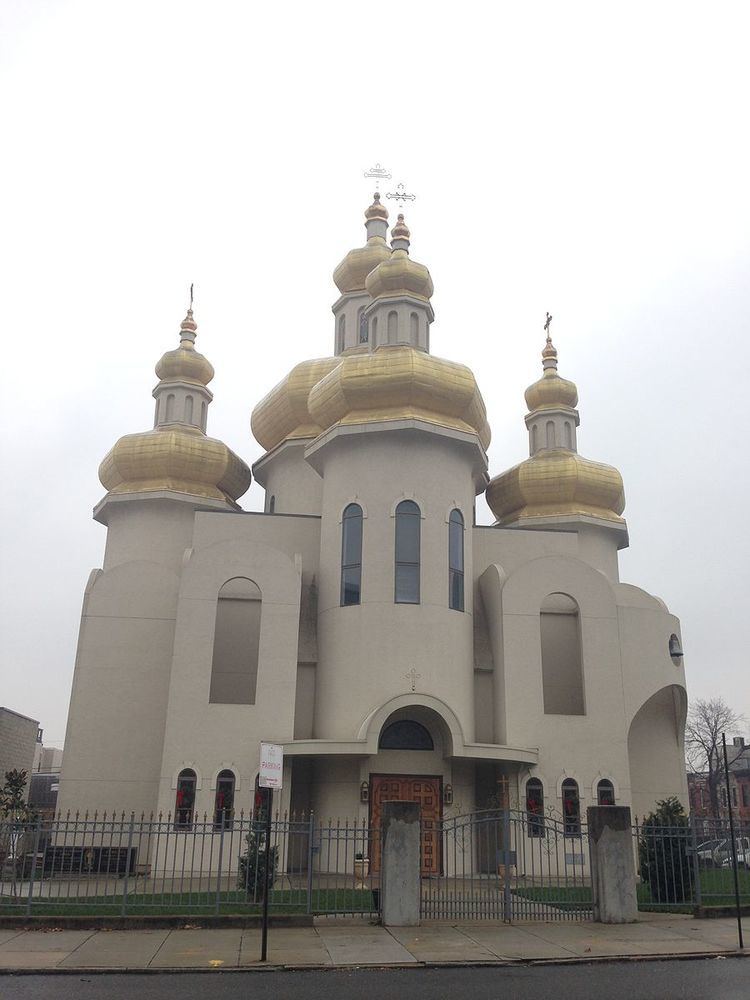 | ||
The history of the Ukrainians in Baltimore dates back to the mid-19th century. Baltimore, Maryland and Washington, D.C. have the largest Ukrainian-American communities in the Mid-Atlantic.
Contents
Demographics
The Ukrainian community in the Baltimore metropolitan area numbered 10,806 as of 2000, making up 0.4% of the area's population. In the same year, Baltimore city's Ukrainian population was 1,567, which is 0.2% of the city's population.
In 1920, 151 foreign-born White people in Baltimore spoke the Ukrainian language, then referred to as the Ruthenian language.
In 1940, 14,670 immigrants from the Soviet Union lived in Baltimore, many of whom were of Ukrainian descent. These immigrants comprised 24.1% of the city's foreign-born white population.
In 2013, an estimated 808 Ukrainian-Americans resided in Baltimore city, 0.1% of the population.
As of September 2014, immigrants from Ukraine were the twentieth largest foreign-born population in Baltimore.
19th century
Ukrainians began settling in Baltimore during the 1880s, mostly in East Baltimore and Southeast Baltimore and especially in the Highlandtown neighborhood. Other Ukrainians settled in Washington Hill and Fell's Point, where there was a Ukrainian store. Most of these immigrants came from Western Ukraine and were Catholic. By the 1890s, Ukrainian Catholic priests were traveling from Pennsylvania to Baltimore to serve the Ukrainian Catholic community. St. Michael the Archangel Ukrainian Catholic Church was founded as a parish in 1893 and the church was built in 1912.
While many immigrants from Western Ukraine identify simply as Ukrainian Americans, others identify as Rusyn American. Rusyns also sometimes describe themselves as Carpatho-Rusyns, Carpatho-Russians or Ruthenians. Some of the Western Ukrainians that established St. Michael the Archangel Ukrainian Catholic Church identified as Rusyns. Rusyns also helped establish Sts. Peter & Paul Ukrainian Catholic Church. Many Rusyn and Western Ukrainians have settled in the neighborhoods of Fell's Point and Patterson Park. Western Ukrainians began immigrating to Baltimore during the 1880s.
20th century
By the 1940s, the Ukrainian community in Highlandtown numbered around 1,200.
Many Ukrainians fled to Baltimore from the 1930s to the 1950s in order to escape political persecution, labor camps, the Holodomor famine, or deportation to Siberia. Every year Ukrainian refugees and their children and grandchildren celebrate their good fortune on Thanksgiving Day by giving a toast and playing a game of football in Patterson Park. On 29 May 2008, the city of Baltimore held a candlelight commemoration for the Holodomor at the War Memorial Plaza in front of City Hall. This ceremony was part of the larger international journey of the "International Holodomor Remembrance Torch", which began in Kiev and made its way though thirty-three countries. Twenty-two other US cities were also visited during the tour. Then-Mayor Sheila Dixon presided over the ceremony and declared 29 May to be "Ukrainian Genocide Remembrance Day in Baltimore". She referred to the Holodomor as "among the worst cases of man's inhumanity towards man".
Beginning in the 1970s, large numbers of Ukrainian Jews immigrated to Baltimore in order to escape antisemitism in the then Soviet Union. In the early 1980s, about 70% of the Soviet Jews in Baltimore had immigrated from the then Ukrainian Soviet Socialist Republic. One-third came from Odessa, Baltimore's sister-city at the time.
Ze Mean Bean Café in Fell's Point opened in 1995. It is a restaurant which offers Ukrainian cuisine, as well as other Slavic and Eastern European fare. The restaurant was founded by Yvonne Dornic as an ode to Ivan Dornic, her Czechoslovakian-born Carpatho-Rusyn father.
21st century
The National Slavic Museum opened in 2012. The museum focuses on the Slavic history of Baltimore, including Baltimore's Ukrainian history.
In light of the 2014 Ukrainian revolution and the Russian intervention in Crimea, Ukrainians in Baltimore have mobilized to support the pro-Ukrainian cause.
Little Ukrainian Village
A corridor of Baltimore's Patterson Park neighborhood is referred to by locals as "The Little Ukrainian Village in Baltimore." The village is home to St. Michael the Archangel Ukrainian Catholic Church and Baltimore's Ukrainian-American festival, as well as organizations for Ukrainians, such as a credit union, a sports club, and a youth association.
